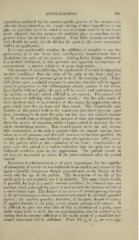Page 891 - My FlipBook
P. 891
DEVITALIZATION. 901
separation produced by the greater specific gravity of the arsenic even
after the long trituration, the simple mixing of these ingredients in the
glass or porcelain vessel in which it was to remain came to be the usual
mode adopted ; for this purpose the ordinary glass or porcelain tooth-
powder boxes are all that is required. Very little creasote or carbolic
acid should be used ; for the thicker the paste is, the more convenient
will be its application.
It is very questionable whether the addition of morphia is any im-
provement, as it has never been satisfactorily demonstrated that it
diminishes the pain of the process. Adding bulky foreign substances
is a decided detriment, as this prevents any approach to exactness of
measurement—a matter which is of great importance.
The amount of jjain following the application of arsenic is dependent
on two conditions : first, the state of the pulp at the time ; and sec-
ondly, the amount of pressure given to it by the covering used. Pulps
will always give a painful response to pressure, but this Avill be aggra-
vated in proportion to the inflammation already present in the tissue.
In a highly-inflamed pulp the pain will be severe and continuous, and
the arsenic, as already stated, will fail to act upon it. The patient will
have hours of suifering with negative results. On the other hand, if
there has been little or no irritation of this organ, the application causes
pain which lasts for an hour and then ceases. The remarkable uni-
formity of this period leads to the conclusion that direct pressure must
have something to do with the pain, but this does not entirely explain
it. It Avould seem as though this amount of time was required to par-
alyze the nerves of sensation, while a longer period is necessary for the
entire devitalizing process. This would appear to be the only reason-
able explanation, as the pain is present when the utmost care has been
taken to avoid pressure, and this Mill continue to the time specified. So
certain is this that in non-irritated pulps the operator can safely prom-
ise his patient relief at the expiration of the hour. Continuation of
pain over this period is a certain indication that the pulp was in an
inflamed condition prior to the apjilication. The patient should in
all cases be instructed to return if the pain continues after the period
named.
Exactness in administration is of great importance, for the rapidity
of absorption of arsenic in non-inflamed tissue renders any excess of the
agent a possible danger—a danger proportionate to the density of the
tooth and the age of the patient. The destruction of the life of the
entire pulp is not required, nor is it desirable. The upper third should,
if possible, be kept in a nearly normal condition ; its removal does not
produce much pain and the parts in and* around the foramen are left in
a much better state. The danger of an excess of arsenic passing through
to the pericementum is always imminent and should be carefully guarded
against ; the smallest quantity, therefore, of the paste should be taken :
if ap]ilied directly to the pulp, a very minute amount will answer. It
is difficult to give any clear idea of this in fractions of a grain, espe-
cially when paste is used, but an approximation may be arrived at by
stating that an amount sufficient to lie on the point of a small hatchet-
shaped excavator will be sufficient. From the to -gLj, or even 3-^,
2V


